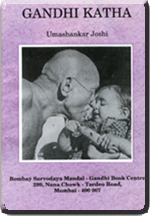
P.O. SEVAGRAM, DIST.WARDHA 442102, MS, INDIA. Phone: 91-7152-284753
FOUNDED BY MAHATMA GANDHI IN 1936

GANDHI KATHA
Written by :Umashankar Joshi
Translated by : Divya Joshi
Table of Contents
- The Miracle of Ramnama
- Equal Care For Everybody
- Motherly Love
- Oneness With Countrymen
- Universe As Family
- Playful Bapu
- The Power of Practice
- Mohan Would Not Steal
- A Lesson for School Children
- The Sportsmanship
- A Lesson Learnt From Mistake
- Its For All!
- Small Thing - Big Lesson
- Saintly Mother
- Unusual Examiner
- The First Satyagrahi
- Nothing is Unimportant
- A Confession
- The Magic of Love
- Always With The Poor
- Practical Approach
- Winning in A Loss
- The Art of Sleeping
- Punctual Bapu
- The First Lesson is Cleanliness
- Smart Kittens
- Ahimsa or Cleanliness ?
- Story Time in Jail
- Bapu - The Host
- The Making of Mahatma
- Ba - The First Satyagrahi
- Heartfelt Sympathy
- Introspective Bapu
- Unflinching Faith
- Firm on Commitment
- An Ordeal for Carelessness
- Self-Suffering
- Self Imposed Discipline
- How I Became Mahatma
- Adans Affection
- A Lesson of Cleanliness
- The Economy at Work
- The Real Friend
- True Ahimsa
- A Lesson for Detachment
- Invaluable Donation
- Anasakti Yoga
- Thinking For Others
- Great Flexibility
- Deep Compassion
- Bapu - The Strategist
- A Novel Leader
- He is Mine !
- Always On Time !
- The Wit of Bapu
- No Security Except God
- No Expensive Fruits For Me !
- The Great Statesman
- Gift For An Opponent
- Be Immortal!
About This Book
Written by :Umashankar Joshi
Translated by : Divya Joshi
First Edition : 3,000 copies, August 2010
Total : 54,000 copies
I.S.B.N :81-7229-095-0
Published by :Bombay Sarvodaya Mandal - Gandhi Book Centre
299 Nana Chowk,
Tardeo Road,
Mumbai 400 007,
MS, India
Navajivan Mudranalaya,
Ahmedabad - 380 014,
India.
Printed by :Jitendra T. Desai
Navajivan Mudranalaya,
Ahemadabad-380014 (INDIA)
© Swati Umashankar Joshi
Download
Chapter-15: Unusual Examiner
In South Africa, Bapuji established the Phoenix ashram and there he also ran a school for the children. His effort and purpose behind this was to provide true education and not the false one, to the children.
His method of giving marks in examinations was always unique. Even though they were all students of the same class and the questions asked to them were also similar, the children who wrote the better answer would get less mark, and others who wrote not so good ones would get more marks.
Due to this method of Bapuji, children would get quite confused. Bapuji would explain to them his method and logic in detail and would also provide the proper understanding: “I do not want to measure that some students are cleverer than the others. But, what I really want to know is, how far each student has improved from where he was standing before. If a clever student keeps comparing himself with a stupid student and shows off his arrogance, then his intelligence will be blunted. He will then put in less effort in his study; and he, who does not progress in study, will ultimately deteriorate for sure. So, I will give more marks to only those who are meticulous and work really hard and who improve constantly.”
Bapuji always kept a watchful eye on a student securing more marks to see whether he is continuously progressing or not. If he keeps boasting about securing more marks than the other less bright students, then what good it will make of him? All these ideas, he constantly tried to impress upon them. And the loving Bapu was always ready to pat the back of a student who obtained better marks next time than before and made a progress.
What Bapu really wanted to explain was this. We are not in a competition with others to show ourselves higher or lower than others. The main thing is to observe how much progress has been made from where we were before. That is true education. Bapu explained this idea to all by making a small, but very important change in the education system.